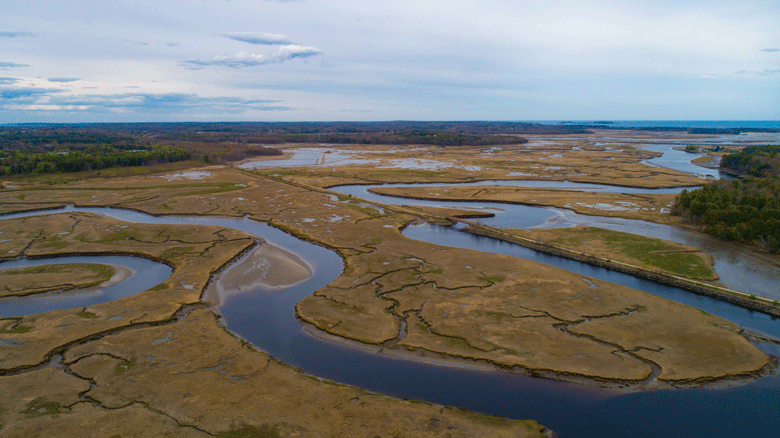Behind the forested dunes of Popham Beach, where the Kennebec River finally meets the sea, is an extensive salt marsh. Great blue herons hunt for eels amid blooms of sea lavender and milkwort; saltmarsh sparrows search for spiders in the grass.
As in all marshes, the grasses and rushes each have their own unique tolerance for salt and flood, and their growth reflects tidal patterns, with fine smooth salt hay and black rush in the upper zones that only flood occasionally, and wider cordgrass along edges, creek banks, and low areas.
With each high tide, plant stems slow the rush of water, allowing sand and silt to settle to the marsh surface before the ebb. With each season, organic matter accumulates as plants grow and die, and their roots and stems build peat in the saturated soil.
Analysis of 31 soil cores at nine sites from Georgia to Maine showed that marsh growth has actually accelerated.
In this way, above and below the surface, salt marshes flourished with the gradually rising sea for thousands of years.
It’s a delicate relationship, however. Any changes, like more frequent flooding, less sediment being delivered, or plants growing faster, can disrupt the equilibrium. Marshes are also running out of room, as waves erode their edges, storms tear them apart, and people convert their grass and mud into lawn, concrete, and pavement. Such conversion has already consumed one-third of the region’s salt marshes.
The acceleration of sea level rise over the last century prompted many coastal ecologists to worry, and this worry only intensified as they started focusing on “blue carbon.” Would the remaining salt marshes be able to keep up, or would they drown? Would salt marshes continue to play an outsized role in sequestering carbon?
In answer, scientists have been measuring rates of marsh growth, deploying filters to capture settling sediment, installing frames of suspended pins that move up and down with the marsh surface, coring into the peat to date the layers and correlate them with historical pollution.
Recently, in Long Island Sound and around Cape Cod, researchers found that marshes were indeed growing at increased rates.
A new coastwide study, led by Nathaniel Weston of Villanova University and funded by the National Science Foundation, confirms these findings. Analysis of 31 soil cores at nine sites from Georgia to Maine showed that marsh growth has actually accelerated.
In many places, including the Kennebec River, marshes are growing vertically two or three times faster than they were 100 years ago. The change in the growth of the marsh appears to closely mirror the change in rates of global sea level rise.
Weston was surprised. His previous research documented declines in the amount of sediment washing down rivers to marshes as a result of reforestation, erosion control, and dam construction.
“We wondered if we could see this signal of changing sediment supply in the marshes, if accretion rates had slowed,” he said. “We didn’t find that. Instead, we found acceleration everywhere.”
Sediment is necessary, but more important for building marsh is the below-ground accumulation of organic matter. In order for the marsh to sequester carbon, it has to escape decomposition by bacteria and fungi which produce carbon dioxide or methane as they break down plants.
Microbial activity is higher in warmer temperatures, and Weston thinks this helps explain slower rates of marsh growth in some of the more southern marshes (the York River in Virginia, Cape Fear River in North Carolina, and Edisto River in South Carolina).
These new findings suggest that rather than being passively “resilient” to rising sea levels, salt marsh ecosystems have the capacity to respond to accelerating rates of change. The response is dynamic, but patchy.
And however well salt marshes have kept up in the past—however well-documented by well-meaning researchers—that response is less and less relevant for predicting the future.
Whether or not salt marshes continue to keep up depends on how fast the sea continues to rise, how much temperatures continue to warm, and whether or not there is a continued source of sediment.
“We are losing marsh in some places, gaining in others,” said Weston. “Overall, we’re going to continue to lose in most systems, some more quickly than others.” A separate study in southern New England found that salt marsh vegetation loss is both widespread and accelerating.
“Marshes are keeping up, until they don’t,” said Weston, who plans on continuing to monitor marshes to identify signals of tipping points. He acknowledged that our information is biased because it is based on data from salt marshes that are surviving, rather than ones that have already disappeared.
“We can’t core a marsh that isn’t there.”
At Popham, the rising sea and shifting sands reshape the beach with each high tide and every storm. The river delivers fine sediment, the marsh grass grows toward the sky, and roots hold everything in its place. For now.





